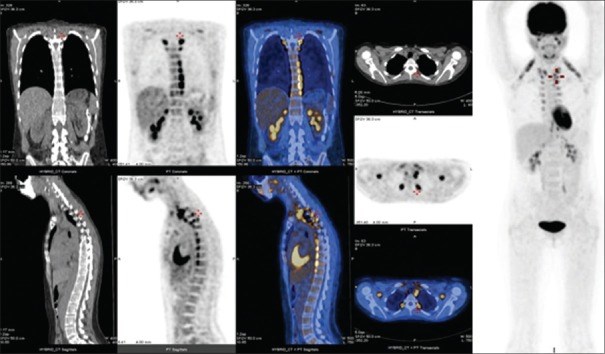Effect of brown adipose tissue activation on myocardial fluorine-18-fluorodeoxyglucose uptake
Affiliations
Affiliations
- Department of Nuclear Medicine, Faculty of Medicine, Kuwait University, Safat, Kuwait.
- Department of Nuclear Medicine, Farwaniya Hospital, Sabah Al Nasser, Kuwait.
- Department of Nuclear Medicine, Mubarak Al-Kabeer Hospital, Jabriya, Kuwait.
- Jaber Al-Ahmad Center for Nuclear Medicine and Molecular Imaging, Kuwait City, Kuwait.
- Department of Radiology, Division of Nuclear Medicine, St. Louis University, St. Louis, MO, USA.
Abstract
The aim of this study is to investigate the relationship between brown adipose tissue (BAT) activation and myocardial fluorine-18-fluorodeoxyglucose ([18F] FDG) uptake in terms of intensity and patterns. The patients were divided into two groups as follows: BAT and control groups. The BAT group consists of 34 cases that showed BAT uptake. The control group, with no BAT uptake, included 68 patients who were matched for body mass index, gender, and season. The scans were retrospectively reviewed by two nuclear medicine physicians who visually evaluated the intensity of myocardial [18F] FDG uptake. The myocardial [18F] FDG uptake was visually classified into the following three patterns: diffuse, heterogeneous, and focal. The regions of activated BAT distribution were noted. The mean myocardial [18F] FDG uptake was 2.50 ± 0.75 for the BAT group and 2.13 ± 0.88 for the control group with a statistically significant difference (P = 0.031). The myocardial [18F] FDG uptake pattern was similar in the BAT and control groups with the diffuse pattern being the most common, followed by the heterogeneous and less commonly focal. In the BAT group, the anatomical distribution of BAT was mainly in supraclavicular, paravertebral, and axillary and to a lesser extent in cervical regions. BAT group had a significantly higher intensity of [18F] FDG myocardial uptake compared to that of the control group. The presence of activated BAT did not affect the pattern of myocardial uptake. Knowledge of these findings may help in understanding the variability of myocardial [18F] FDG uptake and consequently in avoiding misinterpretation of cardiac findings in positron-emission tomography/computed tomography studies.
Keywords: Activated brown adipose fat; fluorine-18-fluorodeoxyglucose; myocardial uptake.
Figures
Similar articles
Gerngroß C, Schretter J, Klingenspor M, Schwaiger M, Fromme T.J Nucl Med. 2017 Jul;58(7):1104-1110. doi: 10.2967/jnumed.116.183988. Epub 2017 Jan 19.PMID: 28104743
Esen Akkas B, Gökaslan D, Güner L, Ilgin Karabacak N.Rev Esp Med Nucl. 2011 Jan-Feb;30(1):14-8. doi: 10.1016/j.remn.2010.05.006. Epub 2010 Aug 10.PMID: 20702004
Perkins AC, Mshelia DS, Symonds ME, Sathekge M.Nucl Med Commun. 2013 Feb;34(2):168-74. doi: 10.1097/MNM.0b013e32835bbbf0.PMID: 23196673
Ouellet V, Routhier-Labadie A, Bellemare W, Lakhal-Chaieb L, Turcotte E, Carpentier AC, Richard D.J Clin Endocrinol Metab. 2011 Jan;96(1):192-9. doi: 10.1210/jc.2010-0989. Epub 2010 Oct 13.PMID: 20943785
Brown adipose tissue: distribution and influencing factors on FDG PET/CT scan.
Hao R, Yuan L, Zhang N, Li C, Yang J.J Pediatr Endocrinol Metab. 2012;25(3-4):233-7. doi: 10.1515/jpem-2012-0029.PMID: 22768649 Review.
KMEL References
References
-
- Paidisetty S, Blodgett TM. Brown fat: Atypical locations and appearances encountered in PET/CT. AJR Am J Roentgenol. 2009;193:359–66. - PubMed
-
- Ouellet V, Routhier-Labadie A, Bellemare W, Lakhal-Chaieb L, Turcotte E, Carpentier AC, et al. Outdoor temperature, age, sex, body mass index, and diabetic status determine the prevalence, mass, and glucose-uptake activity of 18F-FDG-detected BAT in humans. J Clin Endocrinol Metab. 2011;96:192–9. - PubMed
-
- Himms-Hagen J. Brown adipose tissue thermogenesis: Interdisciplinary studies. FASEB J. 1990;4:2890–8. - PubMed
-
- Takx RA, Ishai A, Truong QA, MacNabb MH, Scherrer-Crosbie M, Tawakol A. Supraclavicular brown adipose tissue 18F-FDG uptake and cardiovascular disease. J Nucl Med. 2016;57:1221–5. - PubMed
-
- Saito M, Yoneshiro T. Capsinoids and related food ingredients activating brown fat thermogenesis and reducing body fat in humans. Curr Opin Lipidol. 2013;24:71–7. - PubMed
-
- Sugita J, Yoneshiro T, Hatano T, Aita S, Ikemoto T, Uchiwa H, et al. Grains of paradise (Aframomum melegueta) extract activates brown adipose tissue and increases whole-body energy expenditure in men. Br J Nutr. 2013;110:733–8. - PubMed
-
- de Marchi SF, Schwerzmann M, Billinger M, Windecker S, Meier B, Seiler C, et al. Sympathetic stimulation using the cold pressor test increases coronary collateral flow. Swiss Med Wkly. 2001;131:351–6. - PubMed
-
- Nose H, Otsuka H, Otomi Y, Terazawa K, Takao S, Iwamoto S, et al. The physiological uptake pattern of (18)F-FDG in the left ventricular myocardium of patients without heart disease. J Med Invest. 2014;61:53–8. - PubMed
-
- Browne J, de Pierro AB. A row-action alternative to the EM algorithm for maximizing likelihood in emission tomography. IEEE Trans Med Imaging. 1996;15:687–99. - PubMed
-
- Kaneta T, Hakamatsuka T, Takanami K, Yamada T, Takase K, Sato A, et al. Evaluation of the relationship between physiological FDG uptake in the heart and age, blood glucose level, fasting period, and hospitalization. Ann Nucl Med. 2006;20:203–8. - PubMed
-
- Abel ED. Glucose transport in the heart. Front Biosci. 2004;9:201–15. - PubMed
-
- Maurer AH, Burshteyn M, Adler LP, Steiner RM. How to differentiate benign versus malignant cardiac and paracardiac 18F FDG uptake at oncologic PET/CT. Radiographics. 2011;31:1287–305. - PubMed
-
- Söderlund V, Larsson SA, Jacobsson H. Reduction of FDG uptake in brown adipose tissue in clinical patients by a single dose of propranolol. Eur J Nucl Med Mol Imaging. 2007;34:1018–22. - PubMed
-
- Cronin CG, Prakash P, Daniels GH, Boland GW, Kalra MK, Halpern EF. Brown fat at PET/CT: Correlation with patient characteristics. Radiology. 2012;263:836–42. - PubMed
-
- Basu S, Alavi A. Optimizing interventions for preventing uptake in the brown adipose tissue in FDG-PET. Eur J Nucl Med Mol Imaging. 2008;35:1421–3. - PubMed
-
- Inglese E, Leva L, Matheoud R, Sacchetti G, Secco C, Gandolfo P, et al. Spatial and temporal heterogeneity of regional myocardial uptake in patients without heart disease under fasting conditions on repeated whole-body 18F-FDG PET/CT. J Nucl Med. 2007;48:1662–9. - PubMed
-
- Fallahi B, Moasses-Ghafari B, Fard-Esfahani A, Geramifar P, Beiki D, Emami-Ardekani A. Myocardial18 F-FDG uptake in oncologic PET-CT imaging. Iran J Nucl Med. 2017;25:52–61.


